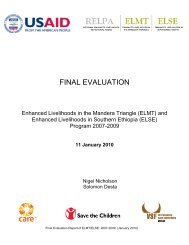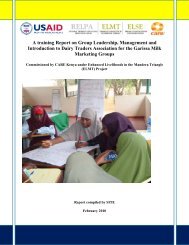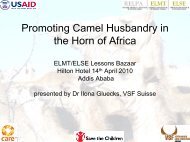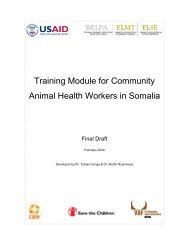Impact Assessment of the Community Animal Health System in ...
Impact Assessment of the Community Animal Health System in ...
Impact Assessment of the Community Animal Health System in ...
Create successful ePaper yourself
Turn your PDF publications into a flip-book with our unique Google optimized e-Paper software.
2.2 Data collection<br />
The data collection methods were designed with VSF Suisse staff based <strong>in</strong> Nairobi, Wajir and Takaba,<br />
who were previously <strong>in</strong>volved <strong>in</strong> <strong>the</strong> design and implementation <strong>of</strong> <strong>the</strong> ELMT project. The impact<br />
assessment was conducted <strong>in</strong> August 2009 by a team <strong>of</strong> three veter<strong>in</strong>arians and a veter<strong>in</strong>ary assistant;<br />
a veter<strong>in</strong>arian from PACAPS (who spoke Somali and Oromo), and three VSF Suisse staff . VSF Suisse<br />
project documents were reviewed to provide <strong>in</strong>formation on project activities.<br />
Key <strong>in</strong>formant <strong>in</strong>terviews<br />
Key <strong>in</strong>formant group and <strong>in</strong>dividual <strong>in</strong>terviews were used to collect <strong>in</strong>formation as follows.<br />
• The availability <strong>of</strong> basic animal health services <strong>in</strong> <strong>the</strong>ir area.<br />
• Livestock movement radius and coverage <strong>of</strong> <strong>the</strong> CAHW service.<br />
• Limitations <strong>of</strong> <strong>the</strong> CAHW service delivery system and suggestions for improvement.<br />
Methods with CAHWs<br />
Information was collected from CAHWs as follows.<br />
• Simple scor<strong>in</strong>g <strong>of</strong> drug suppliers/sources to show replenishment <strong>of</strong> <strong>the</strong>ir veter<strong>in</strong>ary drugs before<br />
and after <strong>the</strong> VSF Suisse/ELMT project support.<br />
• Matrix scor<strong>in</strong>g <strong>of</strong> different drug sources aga<strong>in</strong>st four <strong>in</strong>dicators viz. accessibility, affordability,<br />
quality and availability.<br />
• Simple scor<strong>in</strong>g <strong>of</strong> preferences for different types <strong>of</strong> antibiotics sourced from <strong>the</strong> pharmacies.<br />
• Interviews to exam<strong>in</strong>e <strong>the</strong> advantages and disadvantages <strong>of</strong> be<strong>in</strong>g a CAHW.<br />
Proportional pil<strong>in</strong>g to estimate case fatality rate (CFR)<br />
Proportional pil<strong>in</strong>g was used with livestock keepers to estimate case fatality rates (CFRs) 7 . The<br />
method was designed so that <strong>the</strong>se <strong>in</strong>formants could describe specific variables by livestock species.<br />
• The proportion <strong>of</strong> <strong>the</strong> herd which became sick dur<strong>in</strong>g <strong>the</strong> observation period <strong>of</strong> September 2008<br />
to July 2009, and <strong>the</strong>n, <strong>the</strong> specific diseases which were diagnosed by ei<strong>the</strong>r CAHWs or owners<br />
based on cl<strong>in</strong>ical <strong>in</strong>formation.<br />
• The proportion <strong>of</strong> sick animals treated by disease, and type and source <strong>of</strong> drugs adm<strong>in</strong>istered by<br />
ei<strong>the</strong>r a CAHW or livestock keeper.<br />
• The proportions <strong>of</strong> treated animals which died and survived, by disease and accord<strong>in</strong>g to<br />
treatment by a CAHW or livestock keeper.<br />
The proportional pil<strong>in</strong>g method was standardized and adapted from <strong>the</strong> method which has been<br />
validated with pastoralists <strong>in</strong> east Africa. It used local disease names (Annex 1) and <strong>the</strong> data was<br />
handled as non‐parametric data. Median differences <strong>in</strong> CFR by disease for CAHW‐treated and<br />
owner‐treated herds were calculated us<strong>in</strong>g Confidence Interval Analysis s<strong>of</strong>tware 8 . However, a<br />
dist<strong>in</strong>ction was made between statistical significance and cl<strong>in</strong>ical significance: ‘Statistical significance<br />
tests give an <strong>in</strong>dication <strong>of</strong> <strong>the</strong> probability that observed differences between groups are due to chance. Cl<strong>in</strong>ical<br />
significance concerns <strong>the</strong> relevance <strong>of</strong> f<strong>in</strong>d<strong>in</strong>gs to cl<strong>in</strong>ical veter<strong>in</strong>ary practice. Because statistical significance is<br />
partly dependant on sample size …it is possible that cl<strong>in</strong>ically important results may be overlooked because a<br />
study’s sample size is too small.’ 9 Therefore, although <strong>the</strong> death <strong>of</strong> one camel <strong>in</strong> a herd might not register<br />
7 The case fatality rate (CFR) for a given disease is <strong>the</strong> proportion <strong>of</strong> sick animals which die. Therefore, CFR differs from<br />
mortality rate, which measure <strong>the</strong> number <strong>of</strong> deaths <strong>in</strong> <strong>the</strong> total population due to a given disease; total population <strong>in</strong>cludes<br />
both sick (affected) and health (non‐affected) animals.<br />
8 Altman, D.G., Mach<strong>in</strong>, D., Bryant, T.N. and Gardner, M.J. (2002). Confidence Interval Analysis version 2. British Medical Journal<br />
Books, London.<br />
9 Thrusfield, M. (2005). Veter<strong>in</strong>ary Epidemiology, third edition. Blackwell Publish<strong>in</strong>g, Oxford.<br />
3












